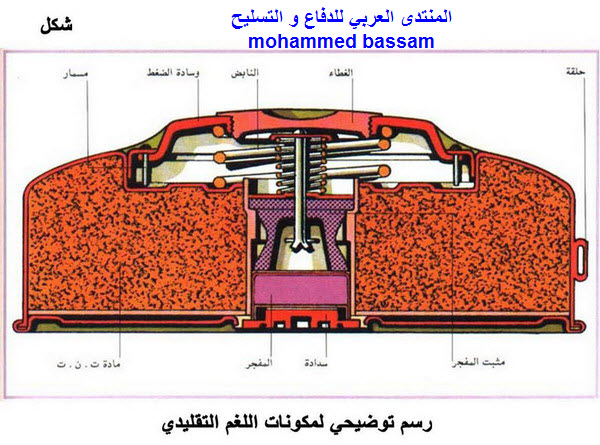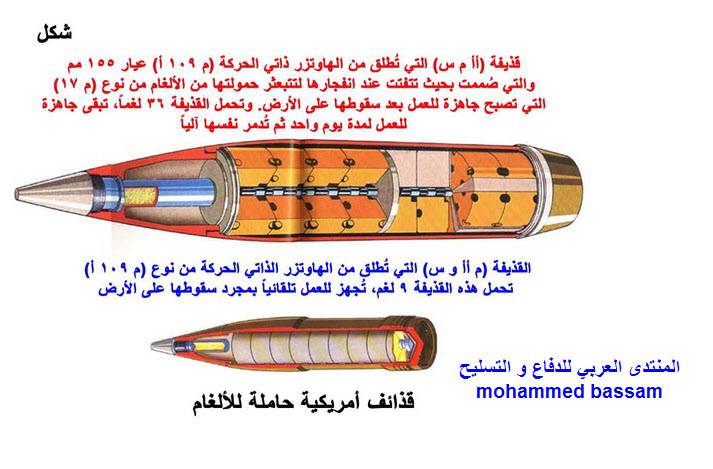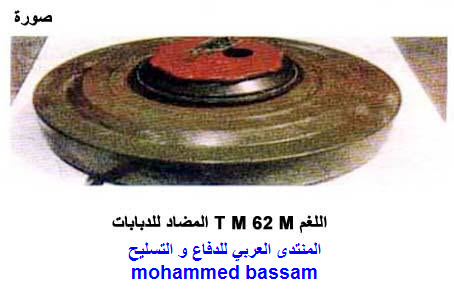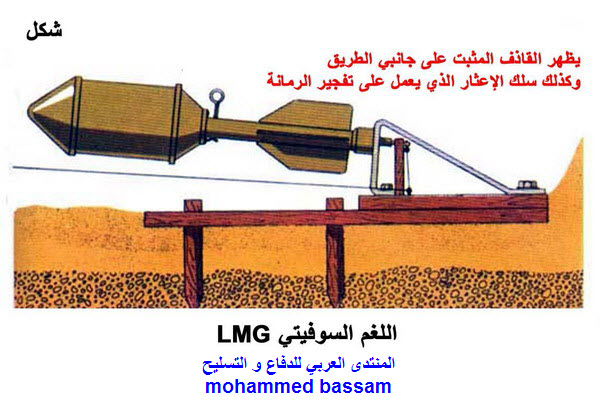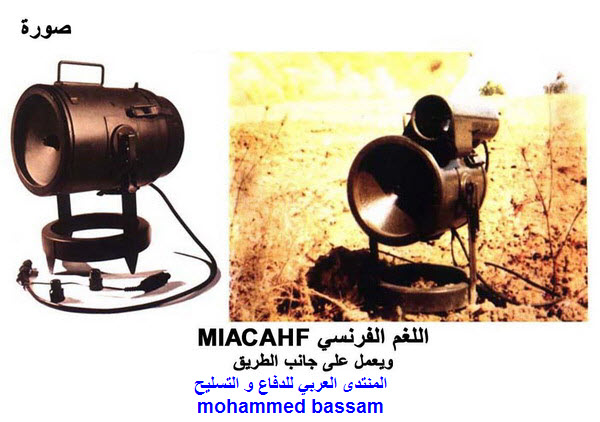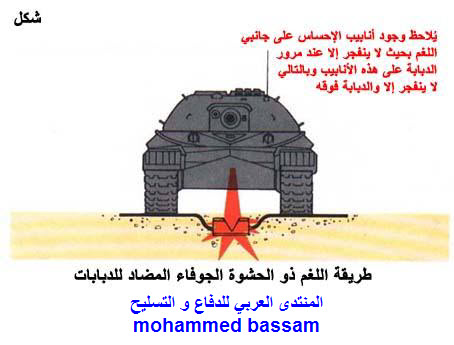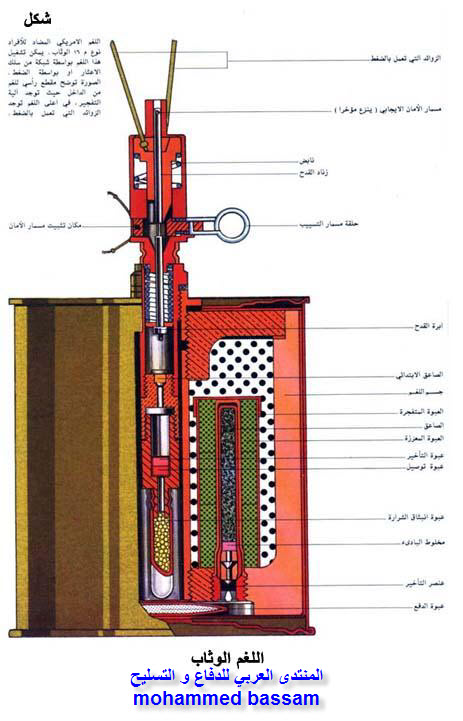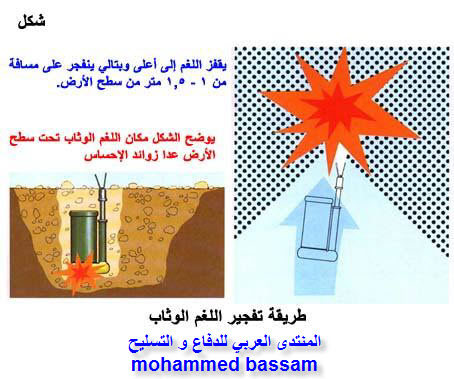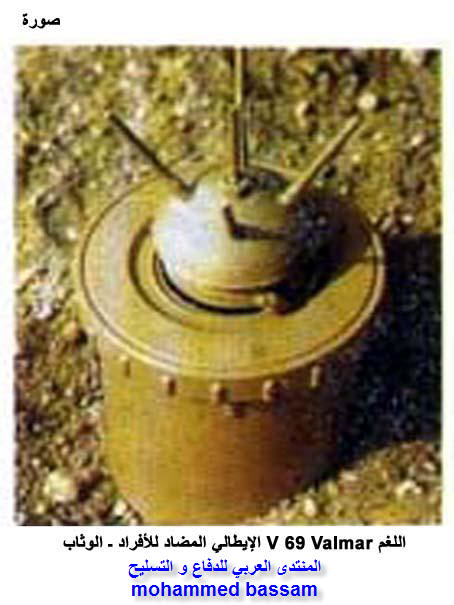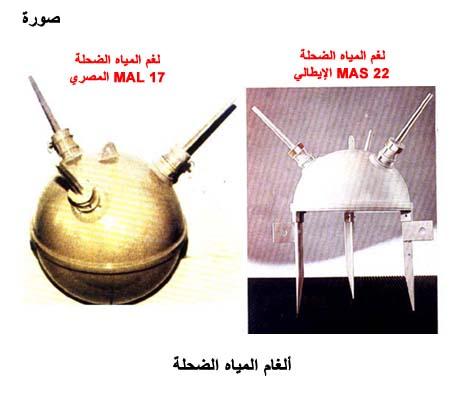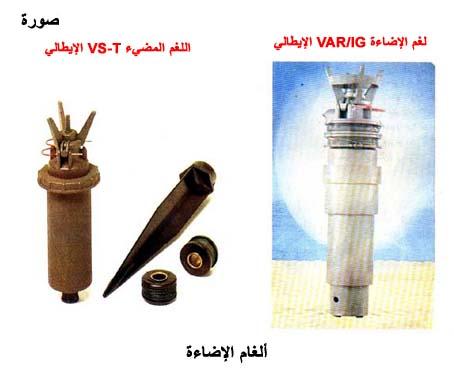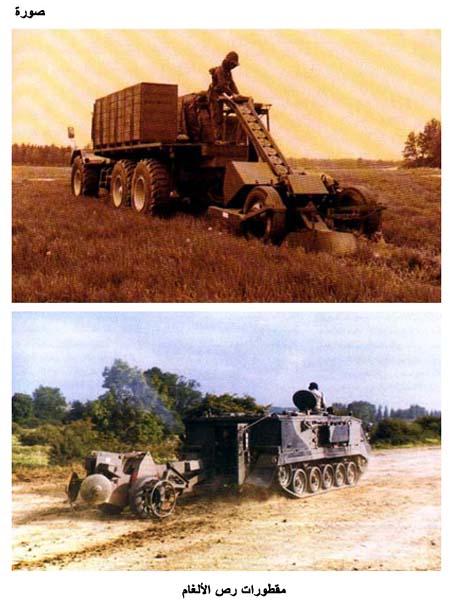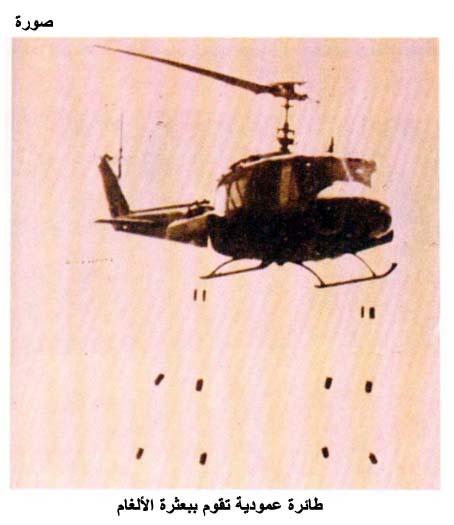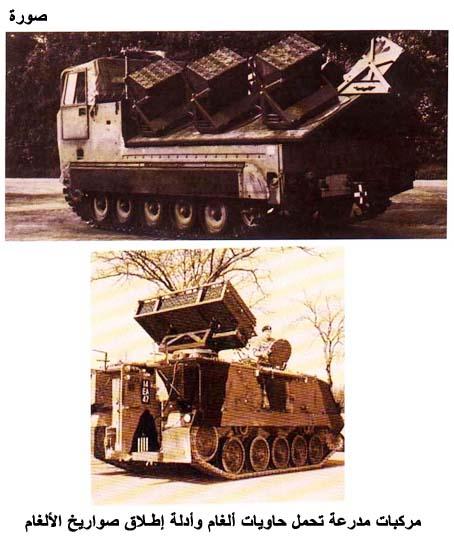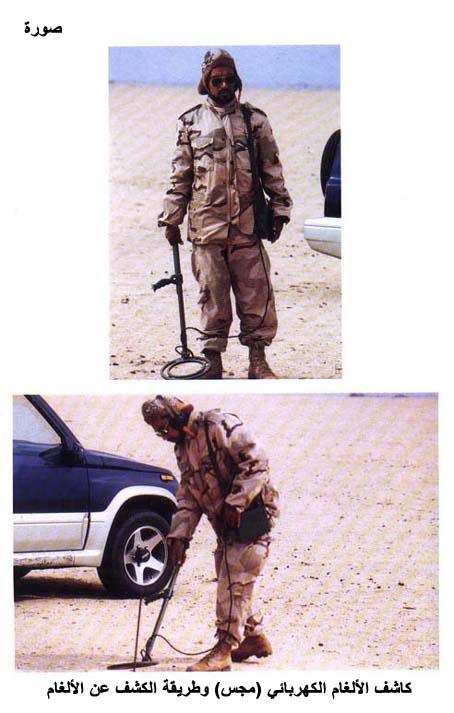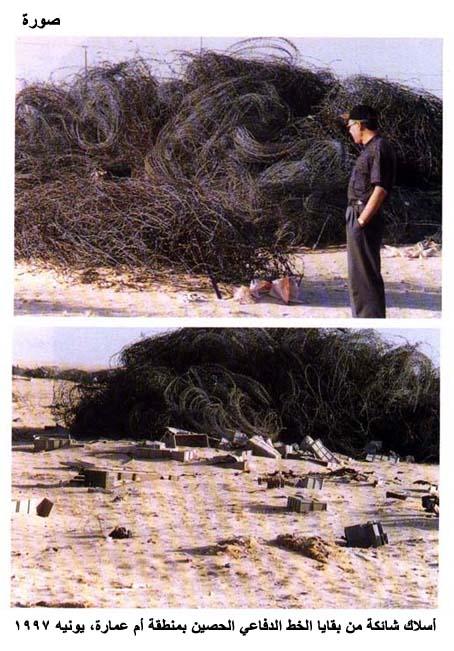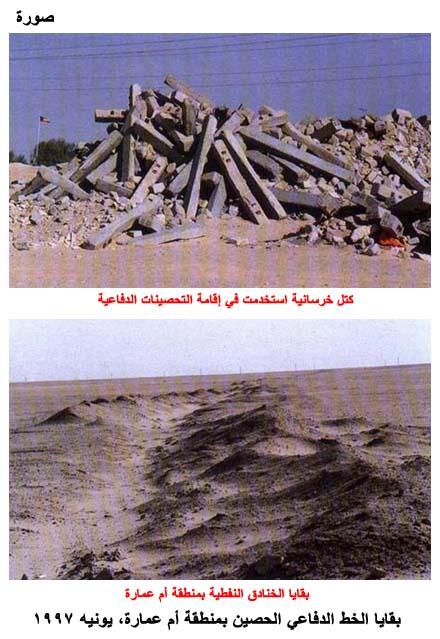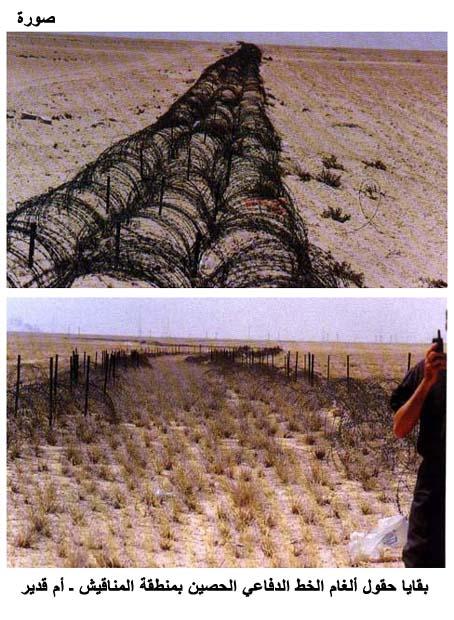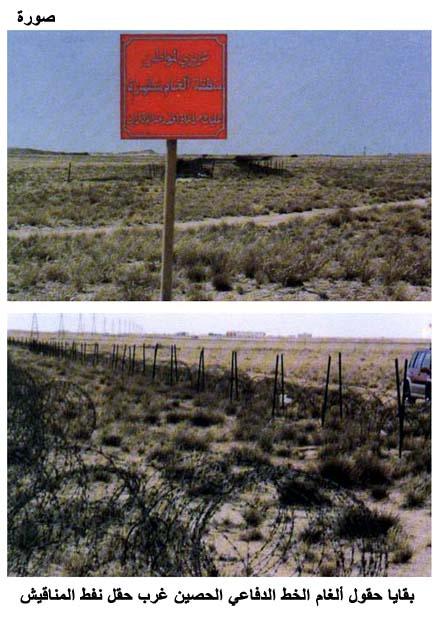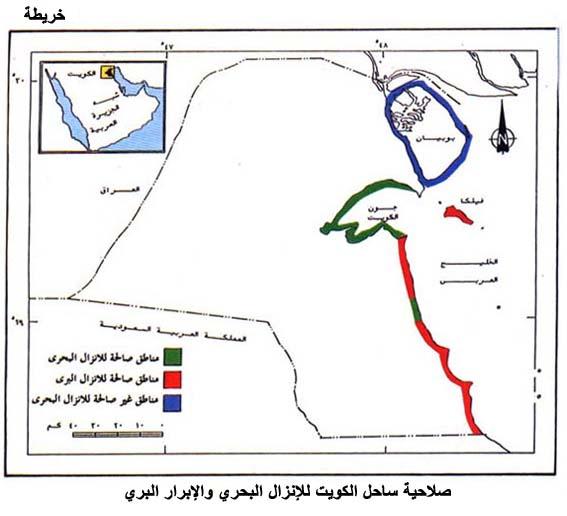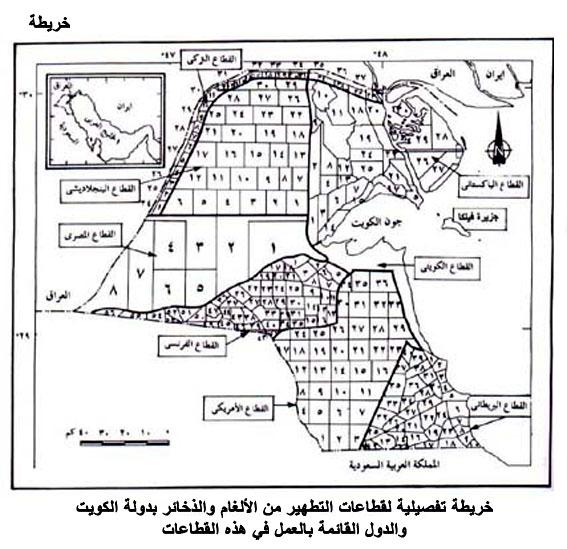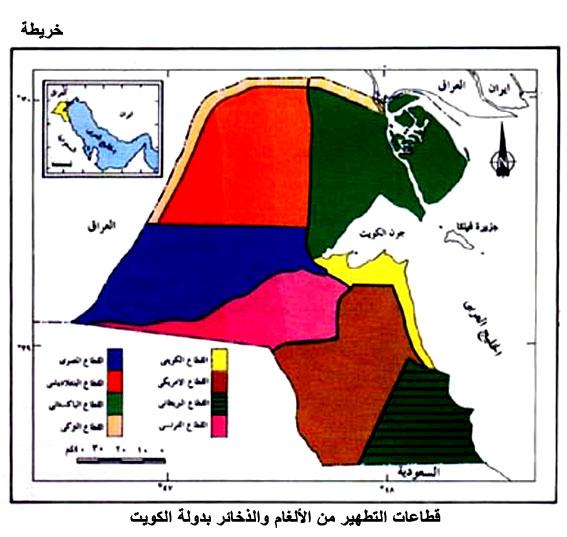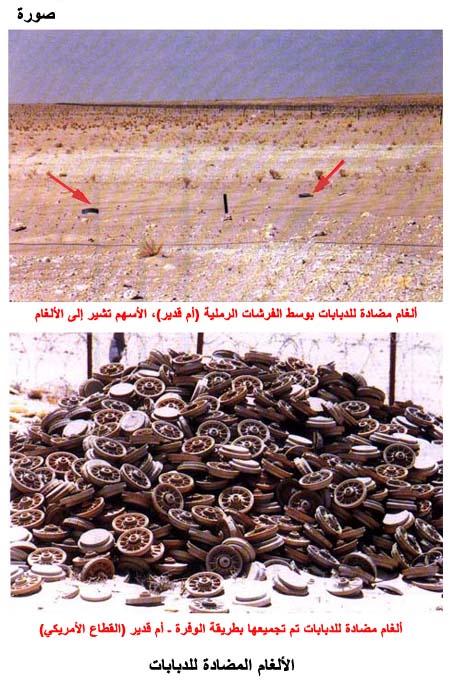استخدام الألغام
أولاً: استخدام الألغام في حرب الخليج الثانية
1. فور انتشار القوات العراقية فوق الأراضي والسواحل الكويتية، في الثاني من أغسطس 1990، بعد اجتياحها دولة الكويت، بدأت في اتخاذ مواقعها الدفاعية، وإعداد تحصيناتها، وزراعة أحزمة الألغام، والتي اعتمدت عليها القوات العراقية في إقامة منظومة متكاملة من الموانع، بهدف عرقلة هجوم القوات المتحالفة، سواء من ناحية الخليج العربي، أو من جهة المملكة العربية السعودية.
وجدير بالذكر، أن عدد الألغام التي زرعتها القوات العراقية بالأراضي الكويتية يقدر ببضعة ملايين، وزرعت على السواحل، والجزر، وبالمناطق الصحراوية.
وكان معظم حقول الألغام، خليطاً من الأنواع المضادة للأفراد والدبابات.
وبعد تحرير الكويت في أواخر شهر فبراير عام 1991، أولت الحكومة الكويتية اهتماماً خاصاً لتطهير البلاد من الألغام، والمتفجرات، وإزالة آثار المعارك الحربية، وبلغ إجمالي عدد الألغام التي أمكن التخلص منها أكثر من مليون ونصف مليون لغم.
2. المخَطط العراقي في استخدام الألغام في مسرح العمليات بالأراضي والسواحل الكويتية
أ. اعتمدت القوات العراقية في أثناء احتلالها لدولة الكويت، على سلاح الألغام، سواء البحرية أو الأرضية، كأداة فعالة لإعاقة تقدم القطع البحرية، والقوات البرية التابعة للقوات المتحالفة، ومنع اقترابها من السواحل والأراضي الكويتية. وكان الهدف الرئيسي للقوات العراقية من استخدام الألغام والموانع الأخرى، هو قطع جميع الطرق أمام تقدم القوات المتحالفة الدولية وإيقاع أكبر خسائر بها.
لذا، فقد استغلت القوات العراقية الألغام، في حماية دفاعاتها، وتأمين أجنابها، وذلك بإقامة أحزمة من الألغام، تمتد من ساحل الخليج العربي شرقاً، إلى وادي الباطن، في أقصى الغرب.
وقد خضعت عمليات زراعة الألغام بالسواحل، والأراضي الكويتية، لمجموعة من المبادئ الأساسية، التي تعبر بشكل واضح عن المنهجية الدفاعية للقوات العراقية.
ب. استخدام الألغام، بنوعيها، في الخطوط الدفاعية العراقية
تتلخص وجهة نظر القيادة العسكرية العراقية، في مسألة استخدام الألغام المضادة للأفراد، والدبابات، في الخطوط الدفاعية، من ناحية العدد، والكثافة، والأنواع، في الآتي:
(1) الألغام المضادة للدبابات
(أ) يعتقد القادة العسكريون العراقيون في التقدير الخاص بمفعول الألغام المضادة للدبابات، والتي استخدمها الألمان في الحرب العالمية الثانية، والذي يقدر أن لكل دبابة من الخسائر كان يقابله 2260 لغم مزروع.
ويفسر هذا الاعتقاد، الكثافة العالية للألغام المضادة للدبابات، بأحزمة الألغام التي زرعتها القوات العراقية، على امتداد الحدود مع المملكة العربية السعودية.
وتشير الإحصائيات، أن متوسط أعداد الألغام، في الكيلومتر المربع، الذي تم رصده، في دولة الكويت.
(ب) من ناحية أخرى تؤمن القوات العراقية، بجدوى الألغام المضادة للدبابات كسلاح مؤثر، لا يقل تأثيره، عن تأثير المدافع المضادة للدبابات.
(2) الألغام المضادة للأفراد
وضعت القوات العراقية، بعض الاعتبارات التكتيكية، في حسبانها عند استخدامها للألغام المضادة للأفراد، منها، الكثافة الشديدة جداً، والتي نفذتها القوات العراقية، بالمناطق المختلفة، من دولة الكويت.
وعلى سبيل المثال، بلغ معدل الألغام التي أزيلت من مناطق من الساحل الشمالي لجون الكويت، حوالي 619 لغماً في كل كم2.
ج. أحزمة الألغام التي أنشأتها القوات العراقية بالمنطقة الجنوبية بدولة الكويت
(1) في ضوء دراسة القوات العراقية لطبيعة الأراضي الكويتية، والتحليل الدقيق لمسرح العمليات، والتي خلص منها أن صحراء الكويت، وخاصة على امتداد الحدود مع المملكة العربية السعودية، تخلو من الموانع الطبيعية، وبالتالي فإن هذه الأراضي برمتها صالحة لتقدم القوات المتحالفة وهجومها، وخاصة القوات الآلية والمدرعة، وإن ذلك كان العامل الرئيسي في أسلوب بناء القوات العراقية لدفاعاتها ومنظومة موانعها.
وقد خطط النظام الدفاعي الحصين للقوات العراقية من الآتي
(أ) منظومة منسقة من الموانع، التي تبدأ بخنادق النفط، ثم ستة صفوف من الزوايا الحديدية بارتفاع 50 سم فوق سطح الأرض، ثم ثلاثة خطوط من الأسلاك الشائكة، يليها أحزمة الألغام المضادة للأفراد والدبابات.
(ب) المواقع، والقطاعات، والنطاقات الدفاعية، بما تحتويه من مرابض كافة الأسلحة، والمدفعيات، وعناصر السيطرة على القوات.
(2
) امتداد ومواصفات أحزمة الألغام
(أ) أوضحت الصور الجوية والفضائية المأخوذة لدولة الكويت في عامي 1991 و1992، ونتائج الزيارات الميدانية، وجود حزامين رئيسيين من الألغام، وذلك على كامل مواجهة جنوب الكويت، وعلى امتداد حدودها مع المملكة العربية السعودية، هذا بالإضافة، إلى بعض الحقول الفرعية الإضافية، والتي تنشأ لأغراض معينة.
والحزامان الرئيسيان، أحدهما أمامي، يمتد بمحاذاة الحدود مع المملكة العربية السعودية، وعلى مسافة تراوح ما بين 3 إلى 15كم شمال الحدود، وثانيهما خلفي، يمتد شمال الخط الأمامي في عمق الأراضي الكويتية، وعلى مسافة تراوح ما بين 15 إلى 21كيلومتر من الخط الأمامي.
(ب) ويتباين التصميم القتالي لأحزمة الألغام، وأنماط توزيعها، وكذلك، المسافة الفاصلة بينهما، من قطاع لآخر، على امتداد الحدود الكويتية ـ السعودية.
وباستعراضها نستخلص الآتي:
· في الجزء الشرقي الذي يبدأ قرب ساحل الخليج العربي، وحتى المناقيش غرباً، بمواجهة حوالي 90 كم، يمتد خط الألغام على شكل فم تمساح مفتوح، يطل ناحية الجنوب الشرقي، حيث يمثل الحزام الشمالي الفك العلوي، ويمثل الحزام الجنوبي الفك السفلي، والمسافة الفاصلة بين الحزامين تصل إلى 21 كم في المنطقة الساحلية، وتتلاشى تدريجياً كلما اتجهنا غرباً، ويلاحظ أن هناك اختلافاً كبيراً في التصميم التكتيكي لحزامي الألغام. والخط الشمالي أكثر بساطة وأقل تعرجاً من الخط الجنوبي، الذي اعتني بتجهيزه ليكون على أعلى كفاءة، كما أُنشئ الكثير من الحقول الثانوية حوله، ودعم بأحزمة ووصلات إضافية من الألغام والموانع الأخرى، وذلك في الاتجاهات الهامة ومحاور التحرك. وقد ذخرت هذه الأحزمة بمزيج قاتل من الألغام المضادة للدبابات والمضادة للأفراد، مما يجعل المنطقة بين الحزامين مصيدة قتل لمن يحاول اقتحامها من أي اتجاه. ويعزى التصميم المحكم لحزامي الألغام في هذا القطاع من دولة الكويت، إلى وجود عدد هائل من الأهداف الإستراتيجية، المدنية والعسكرية، منها حقول نفط البرقان وأم قدير والمناقيش، وشبكة طرق رئيسية، الطريق الساحلي، طريق الوفرة ـ رأس الزور، طريق الوفرة ـ ميناء عبدالله، ومحطة توليد القوى برأس الزور، وقاعدة أحمد الجابر الجوية.
· أمّا الجزء الغربي الذي يبدأ من المناقيش إلى وادي الباطن غرباً بطول حوالي 90 كم، فيمتد حزامي الألغام الشمالي والجنوبي بفاصل يراوح ما بين 1.5 إلى 4 كم، ويمتد الخط الشمالي في اتجاه وادي الباطن، أمّا الخط الجنوبي فهو غير مستقيم في جزئه الشرقي، وتراوح المسافة الفاصلة بينه وبين الحدود مع المملكة العربيـة السعوديـة من 6 إلى 12 كم. كما يلاحظ أن حزام الألغام الجنوبي متقطع وبه ثغرات ولا يوفر التأمين أو الحماية التامة إذا ما قورن بنظيره في القطاع الشرقي، ويعود ذلك إلى عدم وجود أهداف إستراتيجية بالجزء الغربي من ناحية، وإلى امتداده بعيداً عن الساحل الذي كان في نظر القوات العراقية المحور الرئيسي لهجوم القوات المتحالفة، من ناحية أخرى.
(ج) وقد كان لطبيعة دفاعات القوات العراقية، ومنظومة موانعه، وتصميم وامتداد أحزمة ألغامه، أن قامت قيادة القوات المتحالفة بمراجعة كاملة للخطط بحثاً عن نقاط الضعف والثغرات في أحزمة الموانع الدفاعية، والتي أكدت
ضعف القطاع الغربي في مواجهة منطقة وادي الباطن، والتي كانت اتجاهاً رئيسياً للحملة البرية للقوات المتحالفة
د. استخدام الألغام في تأمين سواحل الكويت وجزيرة فيلكا
(1) من الدراسة المستفيضة للسواحل الكويتية، أمكن للقادة العراقيون استنباط المناطق الصالحة للإبرار البحري، وهي:
(أ) المنطقة من رأس الأرض إلى ميناء الأحمدي "بطول 30 كم".
(ب) المنطقة من ميناء الأحمدي ـ ميناء عبدالله "بطول 10 كم"، وتتميز بكثرة المنشآت والمواني النفطية والتجارية.
(ج) ما بين ميناء عبدالله ـ الحدود السعودية "بطول 10 كم". وتمتاز هذه المنطقة بوجود المعسكرات، والحقول النفطية، وقاعدة بحرية وأخرى جوية، وبها تسهيلات وطرق، تجعلها صالحة للإنزال البحري بصورة مثالية.
(د) جزيرة فيلكا.
(2) ونتيجة لما سبق، اعتمدت إستراتيجية القوات العراقية للدفاع عن الساحل، على إنشاء نقط للمراقبة، والاحتفاظ باحتياطي بحجم مناسب، يمكن دفعه في أي اتجاه يتم فيه الإنزال، مع تجهيز نقط حصينة ودفاعات، تُحتل طبقاً للموقف، مع تخصيص قوة للدفاع عن جزيرة فيلكا، وإنشاء نقطة إنذار مبكر بها.
(3) وقد أولى العراقيون بعض المناطق الساحلية، والجزر أهمية خاصة، فكثفوا الألغام بها، كالآتي:
(أ) جزيرة فيلكا: تم زرع 3 حقول ألغام بها، هذا بالإضافة إلى زرع حقول الغام بين النقط الدفاعية بالجزيرة.
(ب) وقد حظيت السواحل الكويتية بأعداد هائلة من الألغام وصلت إلى 77330 لغم، وقد وصلت زراعة حقول الألغام، إلى حد أن زُرعت 3 أحزمة من حقول الألغام في بعض الاتجاهات الهامة.
3. استخدام الألغام في تلغيم وتفجير، آبار النفط والمنشآت الحيوية الكويتية
أ. إن عمليات تدمير المنشئات الحيوية وتخريبها، مثل آبار النفط ومراكز تجميع المياه، وغيرها من الأهداف الإستراتيجية، في دولة الكويت، كانت على رأس قائمة المهام القتالية للقوات العراقية، أثناء احتلالها لدولة الكويت، وقد تم بالفعل تفجير وتدمير أكثر من 750 بئراً نفطية، مع بدء انسحاب القوات العراقية، هذه بخلاف الأهداف الإستراتيجية التي كانت مجهزة للتفجير، ولم يسعفهم الوقت ولا الظروف لتركيب المفجرات بها وإشعالها.
ب. وقد حرص النظام العراقي على تدمير آبار النفط والمنشآت الحيوية الكويتية تدميراً كاملاً، عندما استشعر احتمال انسحابه وفقدانه الأمل في إمكانية تحقيق حلمه في الاحتفاظ بالثروة النفطية الكويتية. وقد ركزت خطتهم في تدمير الآبار المنتجة، واستبعدت الآبار المزودة بصمامات الأمان الجوفية.
ج. وقد وُضعت الحشوات التفجيرية "المادة الناسفة" في الأماكن المناسبة في آبار النفط، التي اشترك في اختيارها ممثلين من وزارة النفط العراقية، وهي الصمامات الرئيسية في رأس البئر والتي تتحكم في خروج النفط من البئر، بما يسمح باندفاع النفط بشدة من الآبار المفجرة، واشتعاله بالشكل الذي يصعب معه إخمادها.
وقد أنهت الأطقم العراقية كافة الأعمال الخاصة بتلغيم الآبار النفطية، والأهداف الإستراتيجية، في فترة سابقة لانسحاب القوات العراقية، ومنعت وضع المفجرات في أماكنها، واحتفظت بها لحين صدور الأوامر بالتفجير في الوقت المطلوب، طبقاً لظروف الموقف.
د. وقد حرصت القوات العراقية على تدريب الأطقم المخصصة لتجهيز الآبار والأهداف للتفجير، وأجرت بياناً عملياً عن مراحل التجهيز بدءاً من تلقي الأمر وحتى المراحل النهائية للتنفيذ، ونفذت تجربة فعلية لتفجير أحد الآبار، للتأكد من تحقيق النتائج.
4
. الجهود الكويتية في تطهير الأراضي الكويتية من الألغام، وإزالة آثار المعارك
أ. بعد تحرير الكويت، بدأت الجهود لإزالة الألغام والقنابل والمتفجرات وغيرها من مخلفات الحرب.
ففي الوقت الذي بدأت فيه الجهود لتطهير المنشئات الحيوية الهامة للدولة، أبرمت عقود مع حكومات بعض الدول الصديقة[1] لتطهير دولة الكويت من مخلفات الحرب، وعلى رأسها الألغام.
ب. وقدرت أعداد الألغام التي تمت إزالتها 1.646.514 لغم، منها 1.078,829 لغم مضاد للأفراد بواقع 65.5% من إجمالي عدد الألغام، والباقي وقدره 567.685 لغم مضاد للدبابات بواقع 34.5% من العدد الإجمالي.
وقد تم تدمير 95.7% من الألغام المضادة للأفراد، 91.4% من الألغام المضادة للدبابات، أمّا الأعداد الباقية فتم تخزينها.
ولا يزال هناك كثير من الألغام المزروعة، في الكويت، مخفية عن الأنظار، تترقب ضحاياها من الأبرياء. ويرجع ذلك إلى الكثافة العالية للألغام، وكذلك التنوع الكبير منها، حيث وجدت على أراضي الكويت أوسع تشكيلة من الألغام القاتلة.
ج. مرت عمليات تمشيط البلاد وتطهيرها، بعدة مراحل، لكل منها أهدافها وآلية تنفيذها، كالتالي:
(1) المرحلة الأولى: ما بعد التحرير مباشرة، في الفترة من مارس 1991 إلى مايو 1991
واستهدفت المطالب العاجلة لتطهير المناطق الحيوية، والأهداف والمنشئات الحكومية والمدنية، لإمكان استئناف الحياة الطبيعية بالمرافق الحساسة "الموانئ والمطارات والمنشئات الصناعية ومصادر المياه، ومحطات توليد القوى، والمدارس والجسور والمناطق السكنية … إلخ.
(2) المرحلة الثانية: خلال الفترة من مارس 1991 إلى ديسمبر 1993
أثناء تنفيذ المرحلة الأولى، أبرمت وزارة الدفاع الكويتية عقود، مع بعض الحكومات والشركات، لتطهير التراب الوطني، من الألغام والذخائر ومخلفات الحرب. وبعد انتهاء مرحلة التطهير العاجلة بدأت فرق التطهير، للدول المشاركة، في تمشيط وتطهير أراضي دولة الكويت، طبقاً لبرامج زمنية وضعت لهذا الغرض.
ولتنفيذ مهام تلك المرحلة قسمت الكويت إلى 8 قطاعات رئيسية، يعمل في كل قطاع فريق لدولة من الدول المشاركة، كما قُسِّم كل قطاع رئيسي إلى عدد من القطاعات الفرعية مختلفة المساحة.
والقطاعات الرئيسية هي:
(أ) القطاع الباكستاني ومساحته 3000 م2
(ب) القطاع البنجلادشي ومساحته 3285 م2
(ج) القطاع المصري ومساحته 3000 م2
(د) القطاع الفرنسي ومساحته 1750 م2
(هـ) القطاع الأمريكي ومساحته 3168 م2
(و) القطاع البريطاني ومساحته 1457 م2
(ز) القطاع التركي ومساحته 696 م2
(ح) القطاع الكويتي ومساحته 1583 م2
(3) المرحلة الثالثة
بعد المرحلة الثانية مباشرة، وهي مستمرة لاستكمال ما لم يتم الانتهاء منه خلال المرحلة الثانية، ومراجعة ضمان جودة ودقة أعمال التطهير خلال المرحلة الثانية، مع تلبية المطالب الجديدة للجهات الحكومية والأهلية، لتطهير أي منطقة للتخلص من المتفجرات والألغام التي تكتشف أو يُعثر عليها.
د. خطط عمل فرق التطهير
عقب توقيع العقود، مع فرق العمل المسؤولة عن التطهير، بدأت في إعداد خطط عملها التفصيلية، التي اشتملت على المراحل التالية:
(1) مرحلة الإعداد والتجهيز. ومدتها 4 شهور، من ديسمبر 1991 إلى أبريل 1992.
(2) مرحلة الأعمال الميدانية: واستغرقت 15 شهر، من إبريل 1992 إلى يوليه 1993 واشتملت على تطهير القطاعات المختلفة من الألغام، إما بتفجيرها في أماكنها أو إزالتها من مواقعها.
http://www.moqatel.com/openshare/Behoth/Askria6/Algham/pic19.jpg
http://www.moqatel.com/openshare/Behoth/Askria6/Algham/pic20.jpg
(3) مرحلة التدقيق النهائية: استغرقت 3 شهور، من يوليه إلى أكتوبر 1993.
وتم خلالها مراجعة وتدقيق كفاءة الأداء لفرق العمل المسؤولة عن التطهير.
هـ. الصعوبات التي واجهت عملية التطهير
(1) صعوبات ناجمة عن قلة المعلومات والبيانات عن حقول الألغام، نظراً إلى أن القوات العراقية لم تقدم الخرائط والسجلات الدقيقة، المسجل بها بيانات حقول الألغام.
ونتج عن ذلك، اتساع نطاق البحث والكشف، وعدم ضمان كفاءة التطهير، بسبب اختفاء الكثير من الألغام.
(2) مشكلات ناجمة عن إهمال القوات العراقية في جمع الألغام وتخزينها بالطرق الصحيحة، وعدم وضع أسوار حول حقول الألغام ووضع الإشارات التحذيرية عليها.
(3) مشكلات ناجمة عن بعض الظواهر الطبيعية السائدة والأحوال المناخية، مما أوجد ظروفاً غير مناسبة لعمل فرق التطهير. كما أن تحرك الكثبان الرملية تسبب كثيراً في إغلاق الطرق، وردم الألغام. وتسببت السيول في جرف الألغام، كما كانت تتولد بعض الشحنات الكهروستاتيكية من احتكاك الرمال، يؤدي إلى الانفجار الذاتي للألغام، خاصة في فصل الصيف. فضلاً عن أن درجة الحرارة العالية كانت تؤثر على كفاءة أجهزة الكشف الإلكترونية.
(4) مشكلات ناجمة عن فتح الثغرات في حقول الألغام، أثناء حرب تحرير الكويت، إذ أدى استخدام بعض قوات التحالف الطائرات في فتح الثغرات، إلى دفن الكثير من الألغام لأعماق كبيرة من دون انفجارها.
(5) اختفاء الألغام تحت البحيرات النفطية والحصر القطرانية، التي غطت ما لا يقل عن 1000 كم2 ، وبطبيعة الحال غطت أعداد هائلة من الألغام والذخائر.
و
. الطرق المستخدمة في تطهير وإزالة الألغام
(1) تنوعت طرق إزالة الألغام، فبعض الفرق استخدمت الطرق الميكانيكية ككاسحات الألغام، وبعضها استخدم أجهزة حديثة، كالفريق البريطاني الذي استخدم آلة تعرف باسم الفلير أو طريقة الكشط، كما أستخدم الدحل لتدمير الألغام في الموقع وفي مكان وجودها، وبعض الفرق استخدمت الطريقة اليدوية كالفريقين، المصري والبنجلاديشي. وقد اتضح أن الطريقة اليدوية على الرغم من خطرها وكثرة حوادثها، هي الأفضل والأكثر دقة في إزالة كافة الألغام الموجودة بالحقل.
وعلى ضوء ذلك، ونظراً إلى أنه ثبت بالتجربة أن استخدام الطرق الميكانيكية والأساليب المتطورة تؤدي إلى إزالة ما لا يزيد عن 10 ـ 15% من الألغام، فقد طُلِبَ من جميع الفرق المشاركة في عمليات التطهير استخدام الطرق اليدوية. وقد استجابت الفرق لهذا المطلب، الذي أدى إلى زيادة كفاءة العمل ورفع نسبة التطهير والإزالة، وقد تم الاستفادة من خبرة الفريق المصري في هذا المجال.
(2) تتلخص فكرة الطريقة اليدوية في الآتي:
(أ) تشكل أفراد التطهير في أطقم، يتكون كل طاقم من ثمانية.
(ب) يُقسّم الحقل إلى قطاعات فرعية، بمواجهة 8 متر وعُمقه بعمق الحقل.
(ج) يُشَكَّل الطاقم، للعمل، في 4 أنساق، وتجرى عملية التطهير والإزالة كالآتي:
النسق الأول: هو الفرد الكشّاف، الذي يتقدم الطاقم ويمسح المنطقة شبراً شبراً، باستخدام كاشف "مجس" الألغام الإلكتروني، الذي يصدر صوتاً بنغمة معينة عند مروره على جسم معدني، قد يكون لغماً.
النسق الثاني: يقوم أفراد النسق الثاني بالحفر حول اللغم المكتشف بحرص، حتى ظهوره كاملا، ثم يُرفع.
النسق الثالث: يقوم أفراد النسق الثالث بتأمين اللغم وإبطال مفعوله.
النسق الرابع: يقوم أفراد النسق الرابع بتجميع الألغام، وتسليم الكبسولات ووضعها في حفرة محددة الموقع، وعمقها 3 ـ 4 م، حيث يجرى تفجيرها باستخدام عجينة متفجرة.
بعد الانتهاء من عملية رفع الألغام وإزالتها في القطاع المحدد، يحدد بعلم بلون معين. ثم ينتقل الطاقم إلى القطاع التالي لتطهيره، ويتكرر هذا العمل إلى أن تنتهي المهمة المخصصة للطاقم.
ثانياً: الألغام في نظر العالم
1. شُبِّهت الألغام، في تقارير اللجنة الدولية للصليب الأحمر، بمقاتلين لا يحملون أسلحة، ولا يخطئون هدفهم، وتعدّ اللجنة أن الألغام هي أكبر منتهكي القانون الدولي لحقوق الإنسان، إذ إنها تمارس الإرهاب من دون تمييز. فمعظم الحروب تنتهي ويعم السلام بينما، يظل اللغم في الأرض يتربص بضحاياه من الأطفال، والنساء، والشباب، والشيوخ، وحتى الدواب، لينفجر فيهم ويقتلهم أو يشوههم ويعوقهم.
2. وكثيراً ما تتسبب الألغام في عدم استثمار الأرض، وعرقلة المشروعات التنموية، وانتشار المجاعات والفقر، خاصة في الدول الفقيرة مثل "إريتريا، والصومال، والسودان، وإثيوبيا، وأنجولا، واليمن".
إن زراعة الألغام في هذه البلاد الفقيرة يضعها بين حدي مقصلة، حدّها الأول الموت أو الإعاقة، وتوقف التنمية، وانتشار الفقر والمجاعات. وحدّها الثاني، هو صعوبة إزالة هذه الألغام لارتفاع نفقتها والتي تصل إلى 1000 دولار للغم الواحد، هذه بالإضافة إلى ضحايا إزالة هذه الألغام.
3. توزيع الألغام في العالم
أ. تشير إحصائية للجنة الدولية للصليب الأحمر إلى الآتي:
(1) ينتشر في العالم حوالي 110 ملايين لغم.
(2) يزرع كل عام ما بين مليونين وخمسة ملايين لغم.
(3) يصنع كل عام ما بين 5 و 10 ملايين لغم.
ب. تنتشر الألغام في عدد كبير من دول العالم وتصنف هذه الدول إلى ثلاث مجموعات كالآتي:
Country/Territories
Total Mines
Total Area Contaminated
Afghanistan
10,000,000
780 sq km
Angola
15.000,000
Austria
Azerbaijan
100,000
Belarus
Belgium
Bosnia and Herzegovina
3,000,000
Burundi
Cambodia
6,000,000
Chad
70,000
China
10,000,000
Colombia
1,500
Costa Rica
Croatia
3,000,000
Cyprus
16,942
Czech Republic
Denmark
9,900
Djibouti
Ecuador
60,000
Egypt
23,000,000
El Salvador
10,000
Eritrea
1,000,000
Ethiopia
500,000
Falklands Islands (Malvinas)
25,000
Georgia
150,000
Germany
Guatemala
1,500
Honduras
35,000
India
Iran, Islamic Republic of
16,000,000
Iraq
10,000,000
Jammu and Kashmir
Jordan
Korea, Republic of
206,193
Kuwait
Lao People's Democratic Republic
Latvia
17,000
Lebanon
8,795
Liberia
18,250
Libyan Arab Jamahiriya
Luxembourg
Mauritania
Mozambique
3,000,000
Myanmar
Namibia
50,000
Netherlands
Nicaragua
108,297
Oman
Peru
Russian Federation
Rwanda
250,000
Senegal
Slovenia
Somalia
1,000,000
Sri Lanka
Sudan
1,000,000
Syrian Arab Republic
Tajikistan
Thailand
Tunisia
Turkey
Uganda
Ukraine
1,000,000
Viet Nam
3,500,000
Western Sahara
Yemen
100,000
Yugoslavia
500,000
Zaire
Zimbabwe
(1) المجموعة الأولى: وتشتمل على الدول التي زُرع بها من ثمانية ملايين إلى 15 مليوناً من الألغام، وهي "أفغانستان، وكمبوديا، والصين، وأنجولا، والعراق".
(2) المجموعة الثانية: وتتضمن الدول التي بها ما بين مليون وثلاثة ملايين، وهي الصومال، والبوسنة، وكرواتيا، وإريتريا، وموزمبيق، والسودان.
(3) المجموعة الثالثة: وتشتمل على الدول التي زرع بها أقل من نصف مليون لغم، وهي أذربيجان، وكوستاريكا، والسلفادور، وإثيوبيا، وجواتيمالا، ونيكاراجوا، واليمن، وجورجيا، وهنداروس، وليبريا، وناميبيا، ورواندا، ويوغسلافيا.
ج. وبدراسة متوسط أعداد الألغام في الكيلومتر المربع في بعض البلدان مقارنـة بمساحتها نجد أن:
(1) أعلى عدد من الألغام في الكيلومتر المربع، تم رصده بدولة الكويت إذ بلغ 92.4 لغم/كم2، وذلك بسبب الكثافة العالية للألغام التي زرعتها القوات العراقية في الكويت.
(2) أقل عدد من الألغام في الكيلومتر المربع تم رصده في اليمن، 0.5 لغم / كم2، تليها الصين لغم واحد/ كم2.
4. ضحايا الألغام
تثير الألغام المضادة للأفراد رعب العالم، بسبب قتلها للآلاف من الأبرياء المدنيين الآمنين. فالألغام المضادة للأفراد تقتل و تصيب شهرياً 2000 من نساء وأطفال ومسنين. وتصل نفقة علاج شخص تسبب لغم في بتر ساقه حوالي 3000 دولار أمريكي، في حين أن متوسط دخل الفرد في بعض الدول التي تنتشر بها الألغام حوالي 12 دولار أمريكي شهرياً. ويقدر عدد الأشخاص الذين بترت أعضاؤهم في أنجولا نتيجة لانفجار الألغام بعشرين ألف شخص، بعد خمسة عشر عاماً من الحرب، ومعظمهم من النساء والأطفال.
5. مصاعب عملية إزالة الألغام
من وجهة النظر العسكرية، تعدّ عمليات إزالة الألغام من المهام الصعبة والأنشطة المعقدة والخطرة، في الوقت نفسه، ويرجع ذلك إلى الآتي:
أ. ارتفاع نفقة إزالة الألغام، إذ تقدر بحوالي 1000 دولار أمريكي، لإزالة اللغم الواحد، أي مطلوب مائة وعشرة مليارات من الدولارات لإزالة كافة الألغام المنتشرة في العالم.
ب. الخطر الشديد المصاحب لعمليات إزالة الألغام وتفجيرها، إذ تقدر بعض المصادر، أن هناك اثنين من القتلى أمام كل خمسة آلاف لغم، مما يعني أن الخسائر المتوقعة عند إزالة كل الألغام المنتشرة بالعالم "110 مليون لغم" تقدر بحوالي 44 ألف قتيل.
ج. طول الوقت اللازم لتنفيذ مهمة الإزالة والتطهير.
6. حظر استخدام الألغام في القانون الدولي
أ. نتيجة لويلات الحروب، انتبه العالم إلى الأخطار الفادحة التي تصيب البشرية من جراء استخدام الأسلحة بطريقة لا إنسانية، لذلك عُقدت المؤتمرات، وأُبرمت معاهدات دولية، لتنظيم استخدام وسائل القتال الشرسة. وقد بدأت الجهود الدولية اعتباراً من النصف الأخير من القرن التاسع عشر، وكانت أول معاهدة تتعلق بهذا الموضوع، هي إعلان بطرسبورج، في 29 نوفمبر عام 1868، في شأن حظر استعمال بعض القذائف. ومنذ ذلك التاريخ، والعالم ما برح يعقد الاتفاقيات التي تتعلق باستخدام الأسلحة.
ب. التشريع الدولي للألغام
تُعدّ مأساة الدمار الناجم عن الألغام، التي ترقد ملايين منها فوق الأرض أو تحتها، من بين الويلات التي يعانيها سكان المناطق المنكوبة بالنزاعات المسلحة، إذ يوجد حالياً ما يزيد على 70 بلداً بها أكثر من 100 مليون لغم كامن في حالة خمول تتربص بضحاياها، وفي مقدمة الفئات المنكوبة بأضرار الألغام، المزارعون والنساء والأطفال. لذا، حظيت الألغام بنصيب من اهتمامات المنظمات الدولية، والتي أسفرت عن الآتي:
(1) اتفاقية بشأن زرع ألغام التماس البحرية الأوتوماتيكية، لاهاي، في أكتوبر عام 1907.
(2) بروتوكول بشأن حظر أو تقييد استعمال الألغام والشراك الخداعية والنبائط الأخرى، الملحق في اتفاقية حظر استعمال أسلحة تقليدية معينة يمكن اعتبارها مفرطة الضرر أو عشوائية الأثر والمعتمدة في جنيف، في 10 أكتوبر عام 1980.
(3) البروتوكول السابق الإشارة إليه والمتعلق بحظر استعمال الألغام والشراك الخداعية والنبائط الأخرى بصفته المعدلة، في 3 مايو عام 1996.
(4) مشروع اتفاقية حظر استخدام الألغام المضادة للأفراد
بعد أقل من خمسة أشهر، من إقرار البورتوكول المتعلق بحظر استخدام الألغام، والشراك الخداعية، والنبائط الأخرى، أو تقييدها، أصدرت الجمعية العامة للأمم المتحدة، القرار الرقم 51/455، الخاص بإعداد مشروع معاهدة دولية لحظر استخدام الألغام المضادة للأفراد وتخزينها وإنتاجها ونقلها، والذي وافقت عليه 156 دولة، ومنها دولة الكويت، وامتنعت 10 دول. وبناءً على هذا القرار، عُقد في أوتاوا مؤتمر، في أكتوبر 1996، تحت شعار "نحو حظر شامل للألغام المضادة للأفراد"، حضرته 74 دولة، وقد كُلِّفت النمسا بوضع الأسس الضرورية لمعاهدة دولية، ملزمة قانونياً بحظر الألغام المضادة للأفراد، ونوقش هذا الموضوع في مؤتمرين، عُقد أحدهما في بروكسل، والآخر في أوسلو، في 18 سبتمبر 1997، تم على أثره إعلان 89 دولة، عن موافقتها على توقيع الاتفاقية، وتُركت المعاهدة مفتوحة لجميع الدول، للتوقيع عليهـا في أوتاوا؛ في 3، 4 ديسمبر 1997، ووصل عدد الدول الموقعة على الاتفاقية 133 دولة، حتى 29 أكتوبر 1998.
النص الكامل لبنود معاهدة، تحريم استخدام الألغام المضادة للأفراد، وتخزينها، وإنتاجها، ونقلها
CONVENTION ON THE PROHIBITION OF THE USE, STOCKPILING, PRODUCTION AND TRANSFER OF
ANTI-PERSONNEL MINES AND ON THEIR DESTRUCTION
(Included list of signatories to the convention)
Preamble
The States Parties,
Determined to put an end to the suffering and casualties caused by anti-personnel mines, that kill or maim hundreds of people every week, mostly innocent and defenseless civilians and especially children, obstruct economic development and reconstruction, inhibit the repatriation of refugees and internally displaced persons, and have other severe consequences for years after emplacement,
Believing it necessary to do their utmost to contribute in an efficient and coordinated manner to face the challenge of removing anti-personnel mines placed throughout the world, and to assure their destruction,
Wishing to do their utmost in providing assistance for the care and rehabilitation, including the social and economic reintegration of mine victims,
Recognizing that a total ban of anti-personnel mines would also be an important confidence-building measure,
Welcoming the adoption of the Protocol on Prohibitions or Restrictions on the Use of Mines, Booby-Traps and Other Devices, as amended on 3 May 1996, annexed to the Convention on Prohibitions or Restrictions on the Use of Certain Conventional
Weapons Which May Be Deemed to Be Excessively Injurious or to Have Indiscriminate Effects, and calling for the early ratification of this Protocol by all States which have not yet done so,
Welcoming also United Nations General Assembly Resolution 51/45 S of 10 December 1996 urging all States to pursue vigorously an effective, legally-binding international agreement to ban the use, stockpiling, production and transfer of anti-personnel landmines,
Welcoming furthermore the measures taken over the past years, both unilaterally and multilaterally, aiming at prohibiting, restricting or suspending the use, stockpiling, production and transfer of anti-personnel mines,
Stressing the role of public conscience in furthering the principles of humanity as evidenced by the call for a total ban of anti-personnel mines and recognizing the efforts to that end undertaken by the International Red Cross and Red Crescent Movement, the International Campaign to Ban Landmines and numerous other non-governmental organizations around the world,
Recalling the Ottawa Declaration of 5 October 1996 and the Brussels Declaration of 27 June 1997 urging the international community to negotiate an international and legally binding agreement prohibiting the use, stockpiling, production and transfer of anti-personnel mines,
Emphasizing the desirability of attracting the adherence of all States to this Convention, and determined to work strenuously towards the promotion of its universalization in all relevant fora including, inter alia, the United Nations, the Conference on Disarmament, regional organizations, and groupings, and review Conferences of the Convention on Prohibitions or Restrictions on the Use of Certain Conventional Weapons Which May Be Deemed to Be Excessively Injurious or to Have Indiscriminate Effects,
Basing themselves on the principle of international humanitarian law that the right of the parties to an armed conflict to choose methods or means of warfare is not unlimited, on the principle that prohibits the employment in armed conflicts of weapons, projectiles and materials and methods of warfare of a nature to cause superfluous injury or unnecessary suffering and on the principle that a distinction must be made between civilians and combatants,
Have agreed as follows:
Article 1
General obligations
Each State Party undertakes never under any circumstances:
a) To use anti-personnel mines;
b) To develop, produce, otherwise acquire, stockpile, retain or transfer to anyone, directly or indirectly, anti-personnel mines;
c) To assist, encourage or induce, in any way, anyone to engage in any activity prohibited to a State Party under this Convention.
Each State Party undertakes to destroy or ensure the destruction of all anti-personnel mines in accordance with the provisions of this Convention.
Article 2
Definitions
Anti-personnel mine" means a mine designed to be exploded by the presence, proximity or contact of a person and that will incapacitate, injure or kill one or more persons. Mines designed to be detonated by the presence, proximity or contact of a vehicle as opposed to a person, that are equipped with anti-handling devices, are not considered anti-personnel mines as a result of being so equipped.
Mine" means a munition designed to be placed under, on or near the ground or other surface area and to be exploded by the presence, proximity or contact of a person or a vehicle.
Anti-handling device" means a device intended to protect a mine and which is part of, linked to, attached to or placed under the mine and which activates when an attempt is made to tamper with or otherwise intentionally disturb the mine.
Transfer" involves, in addition to the physical movement of anti-personnel mines into or from national territory, the transfer of title to and control over the mines, but does not involve the transfer of territory containing emplaced anti-personnel mines.
Mined area" means an area which is dangerous due to the presence or suspected presence of mines.
Article 3
Exceptions
Notwithstanding the general obligations under Article 1, the retention or transfer of a number of anti-personnel mines for the development of and training in mine detection, mine clearance, or mine destruction techniques is permitted. The amount of such mines shall not exceed the minimum number absolutely necessary for the above-mentioned purposes.
The transfer of anti-personnel mines for the purpose of destruction is permitted.
Article 4
Destruction of stockpiled anti-personnel mines
Except as provided for in Article 3, each State Party undertakes to destroy or ensure the destruction of all stockpiled anti-personnel mines it owns or possesses, or that are under its jurisdiction or control, as soon as possible but not later than four years after the entry into force of this Convention for that State Party.
Article 5
Destruction of anti-personnel mines in mined areas
Each State Party undertakes to destroy or ensure the destruction of all anti-personnel mines in mined areas under its jurisdiction or control, as soon as possible but not later than ten years after the entry into force of this Convention for that State Party.
Each State Party shall make every effort to identify all areas under its jurisdiction or control in which anti-personnel mines are known or suspected to be emplaced and shall ensure as soon as possible that all anti-personnel mines in mined areas under its jurisdiction or control are perimeter-marked, monitored and protected by fencing or other means, to ensure the effective exclusion of civilians, until all anti-personnel mines contained therein have been destroyed. The marking shall at least be to the standards set out in the Protocol on Prohibitions or Restrictions on the Use of Mines, Booby-Traps and Other Devices, as amended on 3 May 1996, annexed to the Convention on Prohibitions or Restrictions on the Use of Certain Conventional Weapons Which May Be Deemed to Be Excessively Injurious or to Have Indiscriminate Effects.
If a State Party believes that it will be unable to destroy or ensure the destruction of all anti-personnel mines referred to in paragraph 1 within that time period, it may submit a request to a Meeting of the States Parties or a Review Conference for an extension of the deadline for completing the destruction of such anti-personnel mines, for a period of up to ten years.
Each request shall contain:
a) The duration of the proposed extension;
b) A detailed explanation of the reasons for the proposed extension, including:
(i) The preparation and status of work conducted under national demining programs;
(ii) The financial and technical means available to the State Party for the destruction of all the anti-personnel mines; and
(iii) Circumstances which impede the ability of the State Party to destroy all the anti-personnel mines in mined areas;
(c) The humanitarian, social, economic, and environmental implications of the extension; and
d) Any other information relevant to the request for the proposed extension.
The Meeting of the States Parties or the Review Conference shall, taking into consideration the factors contained in paragraph 4, assess the request and decide by a majority of votes of States Parties present and voting whether to grant the request for an extension period.
Such an extension may be renewed upon the submission of a new request in accordance with paragraphs 3, 4 and 5 of this Article. In requesting a further extension period a State Party shall submit relevant additional information on what has been undertaken in the previous extension period pursuant to this Article.
Article 6
International cooperation and assistance
In fulfilling its obligations under this Convention each State Party has the right to seek and receive assistance, where feasible, from other States Parties to the extent possible.
Each State Party undertakes to facilitate and shall have the right to participate in the fullest possible exchange of equipment, material and scientific and technological information concerning the implementation of this Convention. The States Parties shall not impose undue restrictions on the provision of mine clearance equipment and related technological information for humanitarian purposes.
Each State Party in a position to do so shall provide assistance for the care and rehabilitation, and social and economic reintegration, of mine victims and for mine awareness programs. Such assistance may be provided, inter alia, through the United Nations system, international, regional or national organizations or institutions, the International Committee of the Red Cross, national Red Cross and Red Crescent societies and their International Federation, non-governmental organizations, or on a bilateral basis.
Each State Party in a position to do so shall provide assistance for mine clearance and related activities. Such assistance may be provided, inter alia, through the United Nations system, international or regional organizations or institutions, non-governmental organizations or institutions, or on a bilateral basis, or by contributing to the United Nations Voluntary Trust Fund for Assistance in Mine Clearance, or other regional funds that deal with demining.
Each State Party in a position to do so shall provide assistance for the destruction of stockpiled anti-personnel mines.
Each State Party undertakes to provide information to the database on mine clearance established within the United Nations system, especially information concerning various means and technologies of mine clearance, and lists of experts, expert agencies or national points of contact on mine clearance.
States Parties may request the United Nations, regional organizations, other States Parties or other competent intergovernmental or non-governmental fora to assist its authorities in the elaboration of a national demining program to determine, inter alia:
a) The extent and scope of the anti-personnel mine problem;
b) The financial, technological and human resources that are required for the implementation of the program;
c) The estimated number of years necessary to destroy all anti-personnel mines in mined areas under the jurisdiction or control of the concerned State Party;
d) Mine awareness activities to reduce the incidence of mine-related injuries or deaths;
e) Assistance to mine victims;
f) The relationship between the Government of the concerned State Party and the relevant governmental, inter-governmental or non-governmental entities that will work in the implementation of the program.
Each State Party giving and receiving assistance under the provisions of this Article shall cooperate with a view to ensuring the full and prompt implementation of agreed assistance programs.
Article 7
Transparency measures
Each State Party shall report to the Secretary-General of the United Nations as soon as practicable, and in any event not later than 180 days after the entry into force of this Convention for that State Party on:
a) The national implementation measures referred to in Article 9;
b) The total of all stockpiled anti-personnel mines owned or possessed by it, or under its jurisdiction or control, to include a breakdown of the type, quantity and, if possible, lot numbers of each type of anti-personnel mine stockpiled;
c) To the extent possible, the location of all mined areas that contain, or are suspected to contain, anti-personnel mines under its jurisdiction or control, to include as much detail as possible regarding the type and quantity of each type of anti-personnel mine in each mined area and when they were emplaced;
d) The types, quantities and, if possible, lot numbers of all anti-personnel mines retained or transferred for the development of and training in mine detection, mine clearance or mine destruction techniques, or transferred for the purpose of destruction, as well as the institutions authorized by a State Party to retain or transfer anti-personnel mines, in accordance with Article 3;
e) The status of programs for the conversion or de-commissioning of anti-personnel mine production facilities;
f) The status of programs for the destruction of anti-personnel mines in accordance with Articles 4 and 5, including details of the methods which will be used in destruction, the location of all destruction sites and the applicable safety and environmental standards to be observed;
g) The types and quantities of all anti-personnel mines destroyed after the entry into force of this Convention for that State Party, to include a breakdown of the quantity of each type of anti-personnel mine destroyed, in accordance with Articles 4 and 5, respectively, along with, if possible, the lot numbers of each type of anti-personnel mine in the case of destruction in accordance with Article 4;
h) The technical characteristics of each type of anti-personnel mine produced, to the extent known, and those currently owned or possessed by a State Party, giving, where reasonably possible, such categories of information as may facilitate identification and clearance of anti-personnel mines; at a minimum, this information shall include the dimensions, fusing, explosive content, metallic content, color photographs and other information which may facilitate mine clearance; and
i) The measures taken to provide an immediate and effective warning to the population in relation to all areas identified under paragraph 2 of Article 5.
The information provided in accordance with this Article shall be updated by the States Parties annually, covering the last calendar year, and reported to the Secretary-General of the United Nations not later than 30 April of each year.
The Secretary-General of the United Nations shall transmit all such reports received to the States Parties.
Article 8
Facilitation and clarification of compliance
1. The States Parties agree to consult and cooperate with each other regarding the implementation of the provisions of this Convention, and to work together in a spirit of cooperation to facilitate compliance by States Parties with their obligations under this Convention.
2. If one or more States Parties wish to clarify and seek to resolve questions relating to compliance with the provisions of this Convention by another State Party, it may submit, through the Secretary-General of the United Nations, a Request for Clarification of that matter to that State Party. Such a request shall be accompanied by all appropriate information. Each State Party shall refrain from unfounded Requests for Clarification, care being taken to avoid abuse. A State Party that receives a Request for Clarification shall provide, through the Secretary-General of the United Nations, within 28 days to the requesting State Party all information which would assist in clarifying this matter.
3. If the requesting State Party does not receive a response through the Secretary-General of the United Nations within that time period, or deems the response to the Request for Clarification to be unsatisfactory, it may submit the matter through the Secretary-General of the United Nations to the next Meeting of the States Parties. The Secretary-General of the United Nations shall transmit the submission, accompanied by all appropriate information pertaining to the Request for Clarification, to all States Parties. All such information shall be presented to the requested State Party, which shall have the right to respond.
4. Pending the convening of any meeting of the States Parties, any of the States Parties concerned may request the Secretary-General of the United Nations to exercise his or her good offices to facilitate the clarification requested.
5. The requesting State Party may propose through the Secretary-General of the United Nations the convening of a Special Meeting of the States Parties to consider the matter. The Secretary-General of the United Nations shall thereupon communicate this proposal and all information submitted by the States Parties concerned, to all States Parties with a request that they indicate whether they favour a Special Meeting of the States Parties, for the purpose of considering the matter. In the event that within 14 days from the date of such communication, at least one-third of the States Parties favours such a Special Meeting, the Secretary-General of the United Nations shall convene this Special Meeting of the States Parties within a further 14 days. A quorum for this Meeting shall consist of a majority of States Parties.
6. The Meeting of the States Parties or the Special Meeting of the States Parties, as the case may be, shall first determine whether to consider the matter further, taking into account all information submitted by the States Parties concerned. The Meeting of the States Parties or the Special Meeting of the States Parties shall make every effort to reach a decision by consensus. If despite all efforts to that end no agreement has been reached, it shall take this decision by a majority of States Parties present and voting.
7. All States Parties shall cooperate fully with the Meeting of the States Parties or the Special Meeting of the States Parties in the fulfillment of its review of the matter, including any fact-finding missions that are authorized in accordance with paragraph 8.
8. If further clarification is required, the Meeting of the States Parties or the Special Meeting of the States Parties shall authorize a fact-finding mission and decide on its mandate by a majority of States Parties present and voting. At any time the requested State Party may invite a fact-finding mission to its territory. Such a mission shall take place without a decision by a Meeting of the States Parties or a Special Meeting of the States Parties to authorize such a mission. The mission, consisting of up to 9 experts, designated and approved in accordance with paragraphs 9 and 10, may collect additional information on the spot or in other places directly related to the alleged compliance issue under the jurisdiction or control of the requested State Party.
9. The Secretary-General of the United Nations shall prepare and update a list of the names, nationalities and other relevant data of qualified experts provided by States Parties and communicate it to all States Parties. Any expert included on this list shall be regarded as designated for all fact-finding missions unless a State Party declares its non-acceptance in writing. In the event of non-acceptance, the expert shall not participate in fact-finding missions on the territory or any other place under the jurisdiction or control of the objecting State Party, if the non-acceptance was declared prior to the appointment of the expert to such missions.
10. Upon receiving a request from the Meeting of the States Parties or a Special Meeting of the States Parties, the Secretary-General of the United Nations shall, after consultations with the requested State Party, appoint the members of the mission, including its leader. Nationals of States Parties requesting the fact-finding mission or directly affected by it shall not be appointed to the mission. The members of the fact-finding mission shall enjoy privileges and immunities under Article VI of the Convention on the Privileges and Immunities of the United Nations, adopted on 13 February 1946.
11. Upon at least 72 hours notice, the members of the fact-finding mission shall arrive in the territory of the requested State Party at the earliest opportunity. The requested State Party shall take the necessary administrative measures to receive, transport and accommodate the mission, and shall be responsible for ensuring the security of the mission to the maximum extent possible while they are on territory under its control.
12. Without prejudice to the sovereignty of the requested State Party, the fact-finding mission may bring into the territory of the requested State Party the necessary equipment which shall be used exclusively for gathering information on the alleged compliance issue. Prior to its arrival, the mission will advise the requested State Party of the equipment that it intends to utilize in the course of its fact-finding mission.
13. The requested State Party shall make all efforts to ensure that the fact-finding mission is given the opportunity to speak with all relevant persons who may be able to provide information related to the alleged compliance issue.
14. The requested State Party shall grant access for the fact-finding mission to all areas and installations under its control where facts relevant to the compliance issue could be expected to be collected. This shall be subject to any arrangements that the requested State Party considers necessary for:
a) The protection of sensitive equipment, information and areas;
b) The protection of any constitutional obligations the requested State Party may have with regard to proprietary rights, searches and seizures, or other constitutional rights; or
c) The physical protection and safety of the members of the fact-finding mission.
15. In the event that the requested State Party makes such arrangements, it shall make every reasonable effort to demonstrate through alternative means its compliance with this Convention.
16. The fact-finding mission may remain in the territory of the State Party concerned for no more than 14 days, and at any particular site no more than 7 days, unless otherwise agreed.
17. All information provided in confidence and not related to the subject matter of the fact-finding mission shall be treated on a confidential basis.
18. The fact-finding mission shall report, through the Secretary-General of the United Nations, to the Meeting of the States Parties or the Special Meeting of the States Parties the results of its findings.
19. The Meeting of the States Parties or the Special Meeting of the States Parties shall consider all relevant information, including the report submitted by the fact-finding mission, and may request the requested State Party to take measures to address the compliance issue within a specified period of time. The requested State Party shall report on all measures taken in response to this request.
20. The Meeting of the States Parties or the Special Meeting of the States Parties may suggest to the States Parties concerned ways and means to further clarify or resolve the matter under consideration, including the initiation of appropriate procedures in conformity with international law. In circumstances where the issue at hand is determined to be due to circumstances beyond the control of the equested State Party, the Meeting of the States Parties or the Special Meeting of the States Parties may recommend appropriate measures, including the use of cooperative measures referred to in Article 6.
21. The Meeting of the States Parties or the Special Meeting of the States Parties shall make every effort to reach its decisions referred to in paragraphs 18 and 19 by consensus, otherwise by a two-thirds majority of States Parties present and voting.
Article 9
National implementation measures
Each State Party shall take all appropriate legal, administrative and other measures, including the imposition of penal sanctions, to prevent and suppress any activity prohibited to a State Party under this Convention undertaken by persons or on territory under its jurisdiction or control.
Article 10
Settlement of disputes
1. The States Parties shall consult and cooperate with each other to settle any dispute that may arise with regard to the application or the interpretation of this Convention. Each State Party may bring any such dispute before the Meeting of the States Parties.
2. The Meeting of the States Parties may contribute to the settlement of the dispute by whatever means it deems appropriate, including offering its good offices, calling upon the States parties to a dispute to start the settlement procedure of their choice and recommending a time-limit for any agreed procedure.
3. This Article is without prejudice to the provisions of this Convention on facilitation and clarification of compliance.
Article 11
Meetings of the States Parties
1. The States Parties shall meet regularly in order to consider any matter with regard to the application or implementation of this Convention, including:
a) The operation and status of this Convention;
b) Matters arising from the reports submitted under the provisions of this Convention;
c) International cooperation and assistance in accordance with Article 6;
d) The development of technologies to clear anti-personnel mines;
e) Submissions of States Parties under Article 8; and
f) Decisions relating to submissions of States Parties as provided for in Article 5.
2. The First Meeting of the States Parties shall be convened by the Secretary-General of the United Nations within one year after the entry into force of this Convention. The subsequent meetings shall be convened by the Secretary-General of the United Nations annually until the first Review Conference.
3. Under the conditions set out in Article 8, the Secretary-General of the United Nations shall convene a Special Meeting of the States Parties.
4. States not parties to this Convention, as well as the United Nations, other relevant international organizations or institutions, regional organizations, the International Committee of the Red Cross and relevant non-governmental organizations may be invited to attend these meetings as observers in accordance with the agreed Rules of Procedure.
Article 12
Review Conferences
1. A Review Conference shall be convened by the Secretary-General of the United Nations five years after the entry into force of this Convention. Further Review Conferences shall be convened by the Secretary-General of the United Nations if so requested by one or more States Parties, provided that the interval between Review Conferences shall in no case be less than five years. All States Parties to this Convention shall be invited to each Review Conference.
2. The purpose of the Review Conference shall be:
a) To review the operation and status of this Convention;
b) To consider the need for and the interval between further Meetings of the States Parties referred to in paragraph 2 of Article 11;
c) To take decisions on submissions of States Parties as provided for in
Article 5; and
d) To adopt, if necessary, in its final report conclusions related to the implementation of this Convention.
3. States not parties to this Convention, as well as the United Nations, other relevant international organizations or institutions, regional organizations, the International Committee of the Red Cross and relevant non-governmental organizations may be invited to attend each Review Conference as observers in accordance with the agreed Rules of Procedure.
Article 13
Amendments
1. At any time after the entry into force of this Convention any State Party may propose amendments to this Convention. Any proposal for an amendment shall be communicated to the Depositary, who shall circulate it to all States Parties and shall seek their views on whether an Amendment Conference should be convened to consider the proposal. If a majority of the States Parties notify the Depositary no later than 30 days after its circulation that they support further consideration of the proposal, the Depositary shall convene an Amendment Conference to which all States Parties shall be invited.
2. States not parties to this Convention, as well as the United Nations, other relevant international organizations or institutions, regional organizations, the International Committee of the Red Cross and relevant non-governmental organizations may be invited to attend each Amendment Conference as observers in accordance with the agreed Rules of Procedure.
3. The Amendment Conference shall be held immediately following a Meeting of the States Parties or a Review Conference unless a majority of the States Parties request that it be held earlier.
4. Any amendment to this Convention shall be adopted by a majority of two-thirds of the States Parties present and voting at the Amendment Conference. The Depositary shall communicate any amendment so adopted to the States Parties.
5. An amendment to this Convention shall enter into force for all States Parties to this Convention which have accepted it, upon the deposit with the Depositary of instruments of acceptance by a majority of States Parties. Thereafter it shall enter into force for any remaining State Party on the date of deposit of its instrument of acceptance.
Article 14
Costs
1. The costs of the Meetings of the States Parties, the Special Meetings of the States Parties, the Review Conferences and the Amendment Conferences shall be borne by the States Parties and States not parties to this Convention participating therein, in accordance with the United Nations scale of assessment adjusted appropriately.
2. The costs incurred by the Secretary-General of the United Nations under Articles 7 and 8 and the costs of any fact-finding mission shall be borne by the States Parties in accordance with the United Nations scale of assessment adjusted appropriately.
Article 15
Signature
This Convention, done at Oslo, Norway, on 18 September 1997, shall be open for signature at Ottawa, Canada, by all States from 3 December 1997 until 4 December 1997, and at the United Nations Headquarters in New York from 5 December 1997 until its entry into force.
Article 16
Ratification, acceptance, approval or accession
1. This Convention is subject to ratification, acceptance or approval of the Signatories.
2. It shall be open for accession by any State, which has not signed the Convention.
3. The instruments of ratification, acceptance, approval or accession shall be deposited with the Depositary.
Article 17
Entry into force
1. This Convention shall enter into force on the first day of the sixth month after the month in which the 40th instrument of ratification, acceptance, approval or accession has been deposited.
2. For any State which deposits its instrument of ratification, acceptance, approval or accession after the date of the deposit of the 40th instrument of ratification, acceptance, approval or accession, this Convention shall enter into force on the first day of the sixth month after the date on which that State has deposited its instrument of ratification, acceptance, approval or accession.
Article 18
Provisional application
Any State may at the time of its ratification, acceptance, approval or accession, declare that it will apply provisionally paragraph 1 of Article 1 of this Convention pending its entry into force.
Article 19
Reservations
The Articles of this Convention shall not be subject to reservations.
Article 20
Duration and withdrawal
1. This Convention shall be of unlimited duration.
2. Each State Party shall, in exercising its national sovereignty, have the right to withdraw from this Convention. It shall give notice of such withdrawal to all other States Parties, to the Depositary and to the United Nations Security Council. Such instrument of withdrawal shall include a full explanation of the reasons motivating this withdrawal.
3. Such withdrawal shall only take effect six months after the receipt of the instrument of withdrawal by the Depositary. If, however, on the expiry of that six- month period, the withdrawing State Party is engaged in an armed conflict, the withdrawal shall not take effect before the end of the armed conflict.
4. The withdrawal of a State Party from this Convention shall not in any way affect the duty of States to continue fulfilling the obligations assumed under any relevant rules of international law.
Article 21
Depositary
The Secretary-General of the United Nations is hereby designated as the Depositary of this Convention.
Article 22
Authentic texts
The original of this Convention, of which the Arabic, Chinese, English, French, Russian and Spanish texts are equally authentic, shall be deposited with the Secretary-General of the United Nations.
وقد صدرت الاتفاقية بالفعل، ودخلت حيز التنفيذ في 1 مارس 1999.
7. المجهودات والمبادرات الإنسانية لمسؤولين في حكومات بعض الدول والمنظمات الإنسانية
أ. أعلن جورج روبرتسون، وزير الدفاع البريطاني، خلال زيارته للبوسنة والهرسك عن مبادرة بريطانية بشأن الألغام الأرضية، تتألف من خمس نقاط، وتستهدف تطهير مناطق الحروب في العالم من ملايين الألغام، وتؤكد هذه المبادرة رغبة حكومة العمال، برئاسة توني بلير، استمرار الحملة التي قادتها الأميرة الراحلة ديانا سبنسر، من أجل حظر الألغام دولياً.
وتتلخص أهم نقاط الخطة، في الآتي:
(1) إنشاء مراكز تدريب، وتزويد الجيوش بالمعلومات حول الألغام. وقد أقامت، بالفعل، وزارة الدفاع البريطانية مركزاً لتزويد الدول النامية بالخبرة اللازمة لإزالة الألغام.
(2) إجراء المزيد من الأبحاث حول إزالة الألغام.
(3) مضاعفة المبالغ، التي تخصصها بريطانيا لمشروعات تطهير الألغام في دول العالم إلى 10 مليون جنيه إسترليني.
(4) تزويد هيئات الإغاثة بالخبرة البريطانية في إزالة الألغام.
ب. أعلن كانيزو مراوكا، وزير شؤون مجلس الوزراء الياباني، أن موقف بلاده إزاء حظر الألغام المضادة للأفراد، أصبح أكثر إيجابية، وأشار إلى أن وزارة الدفاع اليابانية تؤكد أنه أصبح من الممكن تطوير معدات دفاعية لتحل محل الألغام خلال 9 سنوات.
ج. أعلنت وزيرة الخارجية الأمريكية، مادلين أولبرايت، عن خطة لجمع ما يصل إلى بليون دولار سنوياً، لإزالة حقول الألغام المضادة للأفراد، والتي تقتل آلاف المدنيين سنوياً، وذلك بحلول عام 2010. وأشارت إلى أن هذه الخطة تستهدف زيادة الموارد المخصصة لاكتشاف الألغام المضادة للأفراد وإزالتها، إلى خمسة أضعاف ما هي عليه لتصل إلى بليون دولار سنوياً، بهدف تأمين المدنيين في كل الدول، وجميع القارات، من تهديد الألغام الأرضية بنهاية العقد المقبل.
ويُعدّ ذلك تحولاً في موقف الحكومة الأمريكية الرافض للتوقيع على اتفاقية دولية لحظر الألغام الأرضية.
د. قرار حكومات كل من بلجيكا والدانمرك وهولندا والسويد والنرويج، بوقف كلي لإنتاج الألغام المضادة للأفراد. وقرار الحكومة الإيطالية بإيقاف جزئي لإنتاج الألغام، كما أوقفت الولايات المتحدة الأمريكية صادرات الألغام الأرضية.
هـ. الحملة الدولية لمنظمة الصليب الأحمر، وذلك بهدف حظر الألغام، وجهودها الإنسانية مع ضحايا الألغام الأرضية. وكمثال لذلك قيام اللجنة الدولية للصليب الأحمر بفتح مستشفيات في بعض المناطق في أفغانستان، منها بيشاور وكابول، لعلاج المصابين من ضحايا الألغام. وقد كان للجهود الإنسانية للمنظمة حيال ضحايا الألغام الأرضية، حصولها على جائزة بالزان والتي قدرت ب 800 ألف دولار.
و. في بودابست، اقترح ثلاثة نواب مجريين سن قانون، يقضي بمقاضاة من يزرع الألغام وعَدِّهم مجرمي حرب. وأبدوا أسفهم، أن الدول التي تصنع الألغام لا تتحمل أي مسؤولية في المشاركة في فاتورة إزالتها، واقترحوا أن يتضمن القانون، فرض نفقات إزالة الألغام على من يصنعها ويزرعها.
ز. الجهود والمبادرات الإنسانية للأميرة الراحلة ديانا سبنسر في هذا المجال، وتبنيها حملة لإقناع دول العالم من أجل حظر الألغام دولياً، وقيامها بالكثير من الجولات في الدول، التي تعاني من أخطار الألغام، ومن هذه الجولات الزيارة التي قامت بها لأنجولا، في فبراير عام 1997، لنشر وإعلان محنة الضحايا بين المدنيين.
مع تطور الألغام أصبحت أسلحة مفضلة في الحروب وفي النزاعات الداخلية، ومن وجهة نظر العسكريين فإنها أسلحة تتميز بطول الأمد وتحتفظ بقدرتها على القتل والتشويه طوال عدة أجيـال، كما أنها اقتصادية، فهي سلاح الفقراء وبخاصة دول العالم الثالث والفقيرة ذات المساحات الشاسعة والمليئة بالصراعات الداخلية والخارجية، فعلى سبيل المثال يتكلف اللغم 3 ـ 30 دولار، في حين أن بديله الشرعي من القوات والأسلحة اللازمة لأداء نفس الدور تحتاج إلى ملايين الأضعاف من تكلفة الألغام.
وقد استخدمت الألغام في جميع الحروب التي نشبت بعد الحرب العالمية الثانية، بهدف زيادة القدرة القتالية للطرف المدافع على عرقلة وصد هجوم الطرف المهاجم وحرمانه من حرية الحركة والمناورة بقواته.
وقد تم إنتاج العديد من الألغام بأنواعها المختلفة، كما تعددت الأغراض التي تستخدم فيها، وحدث بها تطور رهيب مما ضاعف من فاعلية تأثيرها.
وقد واجهت عملية تطهير مسارح العمليات من الألغام بعد انتهاء القتال العديد من المصاعب المقعدة، وخاصة المخاطر التي تحيط بأفراد الفرق القائمة بالتطهير، وكذا التكلفة الباهظة لتطهير الأراضي من الألغام، وفي هذا الشأن، يقول مسؤولو الأمم المتحدة إن إزالة الألغام، التي لا تزال مزروعة في جميع أنحاء العالم قد تتكلف مليارات الدولارات، شريطة عدم زرع أي ألغام جديدة.
ونتيجة للمخاطر البشعة التي نتجت من الألغام، جعلت العالم يخطو خطوات سريعة لمحاربة الألغام، وتنظيم استخدامها للحد من هذه المخاطر، وقد ارتفعت الأصوات التي تندد باستخدام الألغام، وظهرت الكثير من المبادرات الدولية التي تدعو إلى حظر استخدام الألغام المضادة للأفراد، باعتبارها أسلحة ممقوتة وغير مقبولة، وكان آخر هذه المجهودات عقد مؤتمر في أوتاوا في أكتوبر عام 1996 تحت شعار "نحو حظر شامل للألغام المضادة للأفراد"، وحضرت هذا المؤتمر 74 دولة، ثم تلا ذلك مناقشة حظر الألغام المضادة للأفراد في مؤتمرين، أحدهما في بروكسل في يونيه عام 1997، والآخر في أوسلو في سبتمبر عام 1997، والذي تم على أثره إعلان 89 دولة عن موافقتها على توقيع اتفاقية حظر استخدام الألغام المضادة للأفراد. وصدرت الاتفاقية بالفعل في أول مارس 1991.
وتنظر الشعوب إلى اتفاقية حظر الألغام المضادة للأفراد، على أنها تؤدي إلى رقي الإنسانية والمحافظة على العنصر البشري الذي يعتبر الثروة الحقيقية للشعوب.
